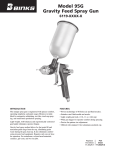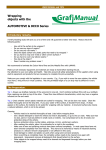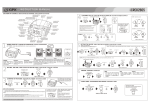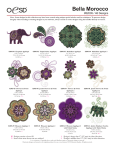Download STOVE BRIGHT® USER GUIDE - The UK home of Stove Bright
Transcript
STOVE BRIGHT® USER GUIDE Because of the high temperatures involved, stove paints are formulated to be used in particular ways. This guide contains instructions for proper use of Stove Bright® High Temperature Paint. Care in following the steps can help prevent the most common problems. Most stoves manufactured in the U.S. and Canada can be repainted with the Stove Bright® High Temperature Paint without problem. There have been rare instances where the paint formulation of the original equipment manufacturer was not compatible with Stove Bright®. Check with your stove manufacturer about the brand of paint used to coat the stove. Then call us (1-800-537-7201) to ask about paint compatibility with Stove Bright®. Another way to check compatibility is to test spray an area of your stove with Stove Bright® to see how it reacts with the original paint. If the stove paint is not compatible with Stove Bright®, or if the stove already has multiple layers of paint, then we strongly recommend removing the paint by sandblasting or sanding down to metal. There are 3 basic steps to paint your stove or stove pipe with Stove Bright® High Temperature Paint: 1. Prepare the surface for paint 2. Apply the paint 3. Set the paint The most critical step is surface preparation. The paint will only adhere as well as whatever is already on the stove. If the stove is rusted, and you do not remove all of the rust, then the paint will adhere to the rust and fail. If the stove has a coating that is peeling, blistering, or chalking, then the new topcoat will release from the stove in the same way. If the stove has grease, oil, dirt or any other contaminant on it, then the paint will not adhere to the metal of the stove. 1. Prepare the surface for paint a. Remove ALL rust. We recommend sandblasting, sanding, or grinding to remove rust. b. Remove oil, grease, graphite, or other hard to remove contaminants. We have found Lacquer Thinner, Toluene, or Acetone to be effective against the toughest surface contaminants. WARNING: Lacquer Thinner, Toluene and Acetone are HIGHLY FLAMMABLE. Do not use near open flame or in close proximity to anything that might spark. Turn off all appliances, extinguish pilot lights, and put out all source of flame. HEALTH WARNING: Lacquer Thinner, Toluene and Acetone give off vapors that are harmful. Do not breathe these vapors in tightly enclosed area. Read and follow all instructions for product use, especially regarding eye protection, skin protection and breathing protection. c. To remove greasy finger prints, light dirt and dust, or simply for your final wipe down before applying the paint, the easy to use Stove Bright® Paint Prep in aerosol is a good choice. d. In any areas where solvents cannot be used in the cleaning process you can used the brand Dirtex® in aerosol or the brand Windex®. Caution: Do NOT use products like Formula 409 or a “tack cloth” sold in many paint stores, because these products ® leave a residue that inhibits the adhesion qualities of Stove Bright High Temperature Paint. Extra effort in surface preparation leads to the best chance for a durable, beautiful finish. Trouble Shooting: Surface preparation If rust is not removed completely before painting, rust will reappear on the newly painted surface over time. Painting ® over rust with Stove Bright High Temperature Paint does not stop oxidation. That is why it is critical to remove all of the rust before painting. Paint coming off the surface in large patches indicates a problem with surface preparation. The best remedy is to remove all the paint, prepare the surface again and repaint. STOVE BRIGHT® USER GUIDE 2. Apply the paint The application of Stove Bright® High Temperature Paint requires some care to get the best results. There are some common techniques for using any aerosol paint and there are details specific to using Stove Bright® in aerosol. a. Shake the can for 2 minutes to completely mix the paint pigment, metallics and solvents for the best uniform finish when sprayed. Some folks do not shake Stove Bright® long enough – this can lead to spitting or even a clogged tip. WARNING: The vapors and propellant coming from the aerosol can are HIGHLY FLAMMABLE. Extinguish all flames and keep away from sources of spark when spraying. HEALTH WARNING: Vapors are harmful if breathed directly. Use the product in a well-ventilated area. Use eye protection to avoid accidental contact with spray. Wear gloves and appropriate clothing to avoid skin irritation due to contact with the solvents and other chemicals in the paint. b. BEFORE you spray the paint on the stove or stove pipe note the following: i. Best results are achieved when the paint, the surface of the stove and the air temperature are above 65° F and below 85°F. You can warm a cold can of paint (from warehouse storage or left in a service truck in cold temperatures) by running hot tap water over it for two minutes. Do not over heat the can or expose it to open flame of any kind. ii. Be sure the area is well-ventilated, that all open flames have been extinguished and that you are wearing appropriate protection for spraying the paint (eye protection, etc.). iii. Test spray on a piece of cardboard to be sure the paint is ready for use. Often the first spray from an aerosol can is mostly propellant with very little pigment. This test spray will bring the well-shaken paint mixture to the tip ready for your first pass on the surface. c. Two or three light coats are better than attempting one heavy coat. d. Your first coat should be a “mist” coat. It should look like dots on the surface. Trying to cover the surface in a single pass will likely result in drips and runs of this thin paint. e. Paint should be sprayed from about 12 to 15 inches. If you get too close, the paint will likely drip or run. If you get too far away, the paint will dry in the air and result in a gritty finish. f. The paint typically dries to touch in about 20 minutes. When doing two light coats as recommended above, you can apply the second coat after about 15 minutes. The paint will dry to handle in about 2 hours. We recommend waiting for 4 hours before doing the “initial firing process” (see the next section). The paint can fully air cure without any heat in about 5 days. The paint is formulated to be heat set for the long-lasting, durable, heat-resistant finish you expect from Stove Bright® High Temperature Paint. Trouble Shooting: Application If the paint peels or looks like shattered glass and comes off in thin strips, this is an indication that too much paint was applied. The best remedy for this condition is to remove as much of the paint as possible, wipe down the surface (as described in surface preparation) and repaint; taking care to apply the paint in two light coats while spraying from at least 12 inches from the surface (but not farther than 18” from the surface). If the finish is textured or gritty, it indicates dry spray occurred during application. This happens when the spray tip is too far from the surface, and the paint actually partially dries in the air before reaching the surface. The best remedy for this condition is to sand off the gritty areas, wipe down the surface (as described in surface preparation) and repaint; taking care to apply a light coat from a distance of less than 18 inches from the surface of the stove (but not closer than 12” from the surface). STOVE BRIGHT® USER GUIDE 3. Set the paint For a wood burning stove follow these guidelines: a. Wait 4 hours before igniting a fire in the stove. b. Build a small kindling fire to start. The kindling fire should be kept burning for 10 to 15 minutes. c. Add fuel to build a medium size fire to bring the stove surface temperature to about 450°. d. The medium size fire should be kept burning for about 60 minutes. e. For the final stage of curing, add fuel to this fire to make it a very hot fire (surface temperature above 600°F) and keep it at this level for about 60 minutes. For a pellet burning stove follow these guidelines: a. Wait 4 hours before igniting a fire in the stove. b. Start the pellet stove according to the manufacturer’s instructions. c. Once lit, moderate the pellet fuel and air mix for a very low burn for 10 minutes d. Increase the fuel and air mixture in the pellet stove to a medium level and allow to burn 60 minutes. e. Increase the air and fuel mixture to its highest levels to burn as hot as possible for 60 minutes. For a gas burning stove follow these guidelines: a. Wait 4 hours before igniting a fire in the stove. b. Start the gas stove according to the manufacturer’s instructions. c. Once lit, moderate the gas for a low burn for 10 minutes d. Increase the gas setting to a medium level and allow to burn 60 minutes. e. Increase the gas stove setting to its highest levels to burn as hot as possible for 60 minutes. NOTE: During the final higher temperature burn phase there may be some visible smoke near the stove surface. There may also be an unpleasant odor. To mitigate this effect, ventilate the room with open windows and doors to provide airflow. HEALTH WARNING: The smoke from the curing process displaces oxygen. Small children, elderly folks and persons with existing breathing problems should vacate the area during the hot burn to avoid the discomfort of lost oxygen. The smoke is primarily Carbon Dioxide, and therefore nontoxic but uncomfortable. Trouble Shooting: Paint curing Take care to build slowly to the medium temperature fire. Building a hot fire immediately will “shock” the paint and cause it to release from the surface. The only remedy to this problem is to remove the paint, prepare the surface for repainting, and repaint. To avoid problems during the curing process, do not touch the surface with anything until the paint is fully cured. If something touches the surface during the curing process, the remedy is to sand, clean the area, and repaint. ® Cured paint will be flat in terms of gloss. Many of the colors of Stove Bright High Temperature Paint contain metallic flake, giving a nice reflective quality to the finish. STOVE BRIGHT® USER GUIDE There are several reasons why an aerosol can of paint doesn’t spray: 1. The aerosol tip is clogged with dried paint. 2. Paint solids have separated from solvent clogging the draw tube or the valve. 3. Can is no longer effectively charged with propellant, so there is no pressure to force the paint up through the valve. 4. Paint is old and has separated from the solvent and cannot be re-mixed. 1. To clear the clogged tip: a. Be sure paint can is at room temperature (let it sit for several hours in 70° room or place can in hot tap water for 2 to 3 minutes) b. Shake the can vigorously for at least 90 seconds. This is a long time to shake a can and requires some patience and effort to get the job done. c. Remove the old regular spray tip and insert the new regular tip (black). d. Turn the can upside down and spray a test on cardboard … if the can sprays, then be sure the spray is clear (only propellant). This will mean your tip is clear and ready for use. If no spray comes out, or if the spray sputters, it indicates a clog in the draw tube. 2. To clear the draw tube you should: a. Be sure paint can is at room temperature (let it sit for several hours in 70° room or place can in hot tap water for 2 to 3 minutes) b. Shake the can vigorously for at least 90 seconds. This is a long time to shake a can and requires some patience and effort to get the job done. c. Remove the regular spray tip and insert the clear-out tip (green). d. Spray the paint on test cardboard for several seconds until the paint appears to flow freely. e. Replace the clear-out tip with a new regular tip. f. Turn can upside-down and press trigger until no paint comes out (only propellant). 3. No propellant in the can a. The easiest test for this is to squeeze the can. If the sides of the can give way easily (like an empty soda pop can) then there is not enough propellant to drive the paint out of the can. b. See you dealer for a replacement can of paint. 4. Old paint a. Look at the bottom of the can for a date and batch number. b. If the date is more than 3 years past, then it is possible the product is too old and won’t ever come out of the can. c. Get a replacement can












